RANS- and TFC-Based Simulation of Turbulent Combustion in a Small-Scale Venting Chamber
Abstract
:1. Introduction
2. Methodology
2.1. The Laboratory-Scale Chamber
2.2. flameFoam
2.3. Initial and Boundary Conditions
3. Results
3.1. Comparison with Experimental Results
3.2. Study of Flame Propagation
4. Conclusions
Author Contributions
Funding
Institutional Review Board Statement
Informed Consent Statement
Data Availability Statement
Conflicts of Interest
References
- Nazir, H.; Muthuswamy, N.; Louis, C.; Jose, S.; Prakash, J.; Buan, M.E.; Flox, C.; Chavan, S.; Shi, X.; Kauranen, P.; et al. Is the H2 economy realizable in the foreseeable future? Part III: H2 usage technologies, applications, and challenges and opportunities. Int. J. Hydrogen Energy 2020, 45, 28217–28239. [Google Scholar] [CrossRef]
- Møller, K.T.; Jensen, T.R.; Akiba, E.; Li, H.-W. Hydrogen—A sustainable energy carrier. Prog. Nat. Sci.-Mater. 2017, 27, 34–40. [Google Scholar] [CrossRef]
- Hosseini, A.E.; Butler, B. An overview of development and challenges in hydrogen powered vehicles. Int. J. Green Energy 2019, 17, 13–37. [Google Scholar] [CrossRef] [Green Version]
- Zhang, G.; Zhang, J.; Xie, T. A solution to renewable hydrogen economy for fuel cell buses—A case study for Zhangjiakou in North China. Int. J. Hydrogen Energy 2020, 45, 14603–14613. [Google Scholar] [CrossRef]
- Teodorczyk, A.; Lee, J.H.S.; Knystautas, R. The structure of fast turbulent flames in very rough, obstacle-filled channels. In Symposium (International) on Combustion; Elsevier: Orléans, France, 1990; Volume 23, pp. 735–741. [Google Scholar] [CrossRef]
- Teodorczyk, A.; Drobniak, P.; Dabkowski, A. Fast turbulent deflagration and DDT of hydrogen–air mixtures in small obstructed channel. Int. J. Hydrogen Energy 2009, 34, 5887–5893. [Google Scholar] [CrossRef] [Green Version]
- Coates, A.M.; Mathias, D.L.; Cantwell, B.J. Numerical investigation of the effect of obstacle shape on deflagration to detonation transition in a hydrogen–Air mixture. Combust. Flame 2019, 209, 278–290. [Google Scholar] [CrossRef]
- Abdel-Raheem, M.A.; Ibraham, S.S.; Malalasekera, W.; Masri, A.R. Large eddy simulation of hydrogen–air premixed flames in a small scale combustion chamber. Int. J. Hydrogen Energy 2015, 40, 3098–3109. [Google Scholar] [CrossRef]
- Elshimy, M.; Ibrahim, S.; Malalasekera, W. Numerical studies of premixed hydrogen/air flames in a small-scale combustion chamber with varied area blockage ratio. Int. J. Hydrogen Energy 2020, 45, 14979–14990. [Google Scholar] [CrossRef]
- Gubba, S.R.; Ibrahim, S.S.; Malalasekera, W.; Masri, A.R. LES Modeling of Premixed Deflagrating Flames in a Small-Scale Vented Explosion Chamber with a Series of Solid Obstructions. Combust. Sci. Technol. 2008, 180, 1936–1955. [Google Scholar] [CrossRef] [Green Version]
- Yehia, M.; Abdel-Aziz, F.; Hassan, M.; Kayed, H. LES Analysis of Equivalence Ratio Effect on Turbulent Premixed Characteristics of LPG Flame Front Propagation. Egypt. J. Eng. Sci. Technol. 2020, 29, 14–27. [Google Scholar] [CrossRef]
- Li, R.; Malalasekera, W.; Ibrahim, S. Numerical study of vented hydrogen explosions in a small scale obstructed chamber. Int. J. Hydrogen Energy 2018, 43, 16667–16683. [Google Scholar] [CrossRef] [Green Version]
- Hasslberger, J.; Kim, H.K.; Kim, B.J.; Ryu, I.C.; Sattelmayer, T. Three-dimensional CFD analysis of hydrogen-air-steam explosions in APR1400 containment. Nucl. Eng. Des. 2017, 320, 386–399. [Google Scholar] [CrossRef]
- Sathiat, P.; Van Haren, S.; Komen, E.; Roekaerts, D. The role of CFD combustion modeling in hydrogen safety management—II: Validation based on homogeneous hydrogen–air experiments. Nucl. Eng. Des. 2012, 252, 289–302. [Google Scholar] [CrossRef]
- Xiao, J.; Travis, J.R.; Kuznetsov, M. Numerical investigations of heat losses to confinement structures from hydrogen-air turbulent flames in ENACCEF facility. Int. J. Hydrogen Energy 2015, 40, 13106–13120. [Google Scholar] [CrossRef]
- Halouane, Y.; Dehbi, A. CFD simulations of premixed hydrogen combustion using the Eddy Dissipation and the Turbulent Flame Closure models. Int. J. Hydrogen Energy 2017, 42, 21990–22004. [Google Scholar] [CrossRef]
- Cherbański, R.; Molga, E. CFD simulations of hydrogen deflagration in slow and fast combustion regime. Combust. Theory Model. 2020, 24, 589–605. [Google Scholar] [CrossRef]
- Ni, J.; Pan, J.; Zhu, Y.; Jiang, C.; Li, J.; Quaye, E.K. Effect of arc obstacles blockage ratio on detonation characteristics of hydrogen-air. Acta Astronaut. 2020, 170, 188–197. [Google Scholar] [CrossRef]
- Tolias, I.; Venetsanos, A. An improved CFD model for vented deflagration simulations—Analysis of a medium-scale hydrogen experiment. Int. J. Hydrogen Energy 2018, 43, 23568–23584. [Google Scholar] [CrossRef]
- Qin, Y.; Chen, X. Flame propagation of premixed hydrogen-air explosion in a closed duct with obstacles. Int. J. Hydrogen Energy 2020, 46, 2684–2701. [Google Scholar] [CrossRef]
- Saeid, M.H.S.; Khadem, J.; Emami, S. Numerical investigation of the mechanism behind the deflagration to detonation transition in homogeneous and inhomogeneous mixtures of H2-air in an obstructed channel. Int. J. Hydrogen Energy 2021, 46, 21657–21671. [Google Scholar] [CrossRef]
- Barfuss, C.; Heilbronn, D.; Sattelmayer, T. Impact of local flame quenching on the flame acceleration in H2-CO-air mixtures in obstructed channels. J. Loss Prev. Process. Ind. 2021, 71, 104491. [Google Scholar] [CrossRef]
- Shen, R.; Jiao, Z.; Parker, T.; Sun, Y.; Wang, Q. Recent application of Computational Fluid Dynamics (CFD) in process safety and loss prevention: A review. J. Loss Prev. Process. Ind. 2020, 67, 104252. [Google Scholar] [CrossRef]
- Zimont, V.; Polifke, W.; Bettelini, M.; Weisenstein, W. An Efficient Computational Model for Premixed Turbulent Combustion at High Reynolds Numbers Based on a Turbulent Flame Speed Closure. J. Eng. Gas Turbines Power 1998, 120, 526–532. [Google Scholar] [CrossRef]
- Bleyer, A.; Taveau, J.; Djebaïli-Chaumeix, N.; Paillard, C.; Bentaïb, A. Comparison between FLACS explosion simulations and experiments conducted in a PWR Steam Generator casemate scale down with hydrogen gradients. Nucl. Eng. Des. 2012, 245, 189–196. [Google Scholar] [CrossRef]
- Wang, Q.; Ma, H.; Shen, Z.; Guo, Z. Numerical Simulation of Premixed Methane-air Flame Propagating Parameters in Square Tube with Different Solid Obstacles. Procedia Eng. 2013, 62, 397–403. [Google Scholar] [CrossRef]
- Sathiah, P.; Komen, E.; Roekaerts, D. The role of CFD combustion modeling in hydrogen safety management—Part I: Validation based on small scale experiments. Nucl. Eng. Des. 2012, 248, 93–107. [Google Scholar] [CrossRef]
- Rakhimov, A.C.; Visser, D.C.; Holler, T.; Komen, E.M.J. The role of CFD combustion modelling in hydrogen safety management—VI: Validation for slow deflagration in homogeneous hydrogen-air-steam experiments. Nucl. Eng. Des. 2017, 311, 142–155. [Google Scholar] [CrossRef]
- Holler, T.; Komen, E.M.; Kljenak, I. The role of CFD combustion modeling in hydrogen safety management—VII: Validation for hydrogen deflagration in large-scale hydrogen-air-steam experiment. Nucl. Eng. Des. 2018, 342, 133–146. [Google Scholar] [CrossRef]
- Li, X.; Zhou, N.; Liu, X.; Huang, W.; Chen, B.; Rasouli, V. Numerical simulation of the influence of pipe length on explosion flame propagation in open-ended and close-ended pipes. Sci. Prog. 2020, 103. [Google Scholar] [CrossRef]
- Sadeq, A.M.; Ahmed, S.F.; Sleiti, A.K. Transient 3D simulations of turbulent premixed flames of gas-to-liquid (GTL) fuel in a fan-stirred combustion vessel. Fuel 2021, 291, 120184. [Google Scholar] [CrossRef]
- Bradley, D.; Lau, A.K.C.; Lawes, M.; Smith, F.T. Flame stretch rate as a determinant of turbulent burning velocity. Philos. Trans. A Math. Phys. Eng. Sci. 1992, 338, 359–387. [Google Scholar] [CrossRef]
- Cantera: An Object-Oriented Software Toolkit for Chemical Kinetics, Thermodynamics, and Transport Processes. Available online: https://www.cantera.org (accessed on 4 September 2021).
- Menter, F.R. Two-equation eddy-viscosity turbulence models for engineering applications. AIAA J. 1994, 32, 1598–1605. [Google Scholar] [CrossRef] [Green Version]
- Li, R.; Malalasekera, W.; Ibrahim, S.; Liu, B. On the mechanism of pressure rise in vented explosions: A numerical study. Process. Saf. Environ. Prot. 2018, 117, 551–564. [Google Scholar] [CrossRef] [Green Version]
- Al-Harbi, A. Turbulent Premixed Flames Propagating Past Repeated Obstacles. Ph.D. Thesis, The University of Sydney, Sydney, Australia, 2013. [Google Scholar]
- Masri, A.R.; AlHarbi, A.; Meares, S.A.; Ibrahim, S.S. A Comparative Study of Turbulent Premixed Flames Propagating Past Repeated Obstacles. Ind. Eng. Chem. Res. 2012, 51, 7690–7703. [Google Scholar] [CrossRef]
- Hargrave, G.K.; Jarvis, S.; Williams, T.C. A study of transient flow turbulence generation during flame/wall interactions in explosions. Meas. Sci. Technol. 2002, 13, 1036–1042. [Google Scholar] [CrossRef]
- Elshimy, M.; Ibrahim, S.; Malalasekera, W. Numerical study of propane and hydrogen turbulent premixed flames in a small scale obstructed chamber. In Proceedings of 14th International Conference on Heat Transfer, Fluid Mechanics and Thermody-namics, Wicklow, Ireland, 22–24 July 2019. [Google Scholar]
- Vermorel, O.; Quillatre, P.; Poinsot, T. LES of explosions in venting chamber: A test case for premixed turbulent combustion models. Combust. Flame 2017, 183, 207–223. [Google Scholar] [CrossRef] [Green Version]
- DI Sarli, V.; DI Benedetto, A.; Russo, G. Large Eddy Simulation of transient premixed flame–vortex interactions in gas explosions. Chem. Eng. Sci. 2012, 71, 539–551. [Google Scholar] [CrossRef]
- Di Sarli, V.; DI Benedetto, A.; Russo, G. Sub-grid scale combustion models for large eddy simulation of unsteady premixed flame propagation around obstacles. J. Hazard. Mater. 2010, 180, 71–78. [Google Scholar] [CrossRef] [PubMed]
- Quillatre, P.; Vermorel, O.; Poinsot, T.; Ricoux, P. Large Eddy Simulation of Vented Deflagration. Ind. Eng. Chem. Res. 2013, 52, 11414–11423. [Google Scholar] [CrossRef]
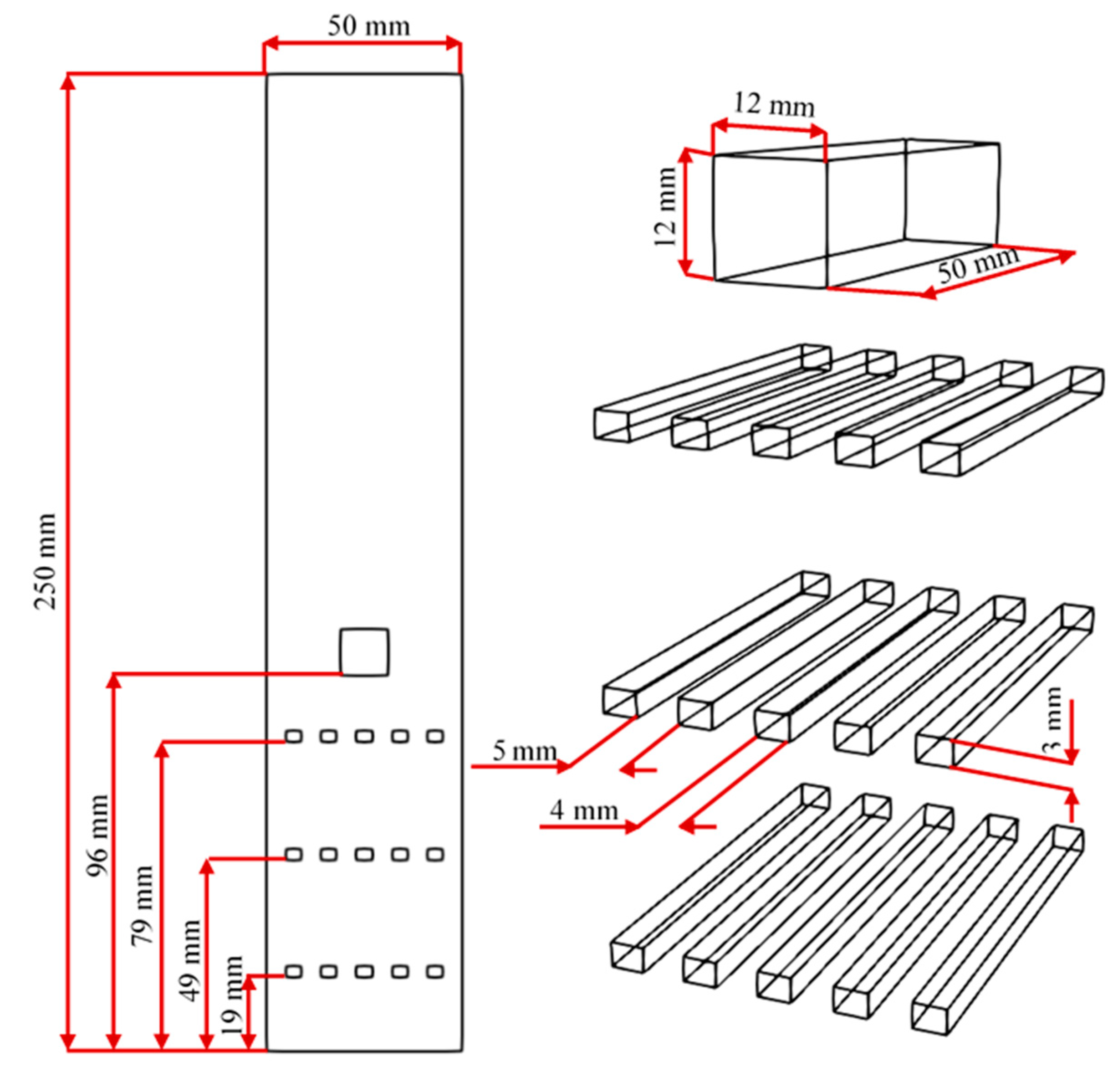
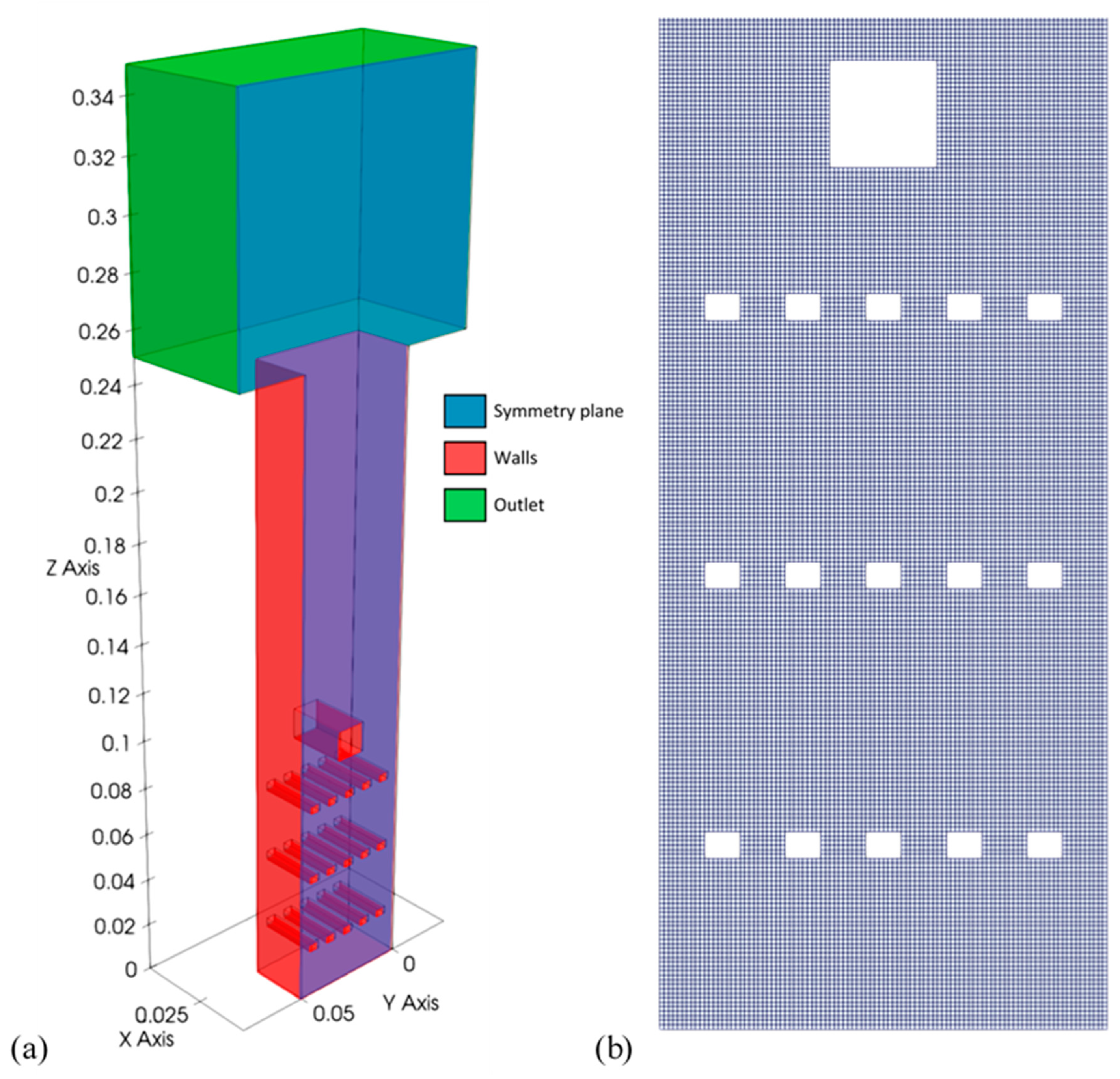
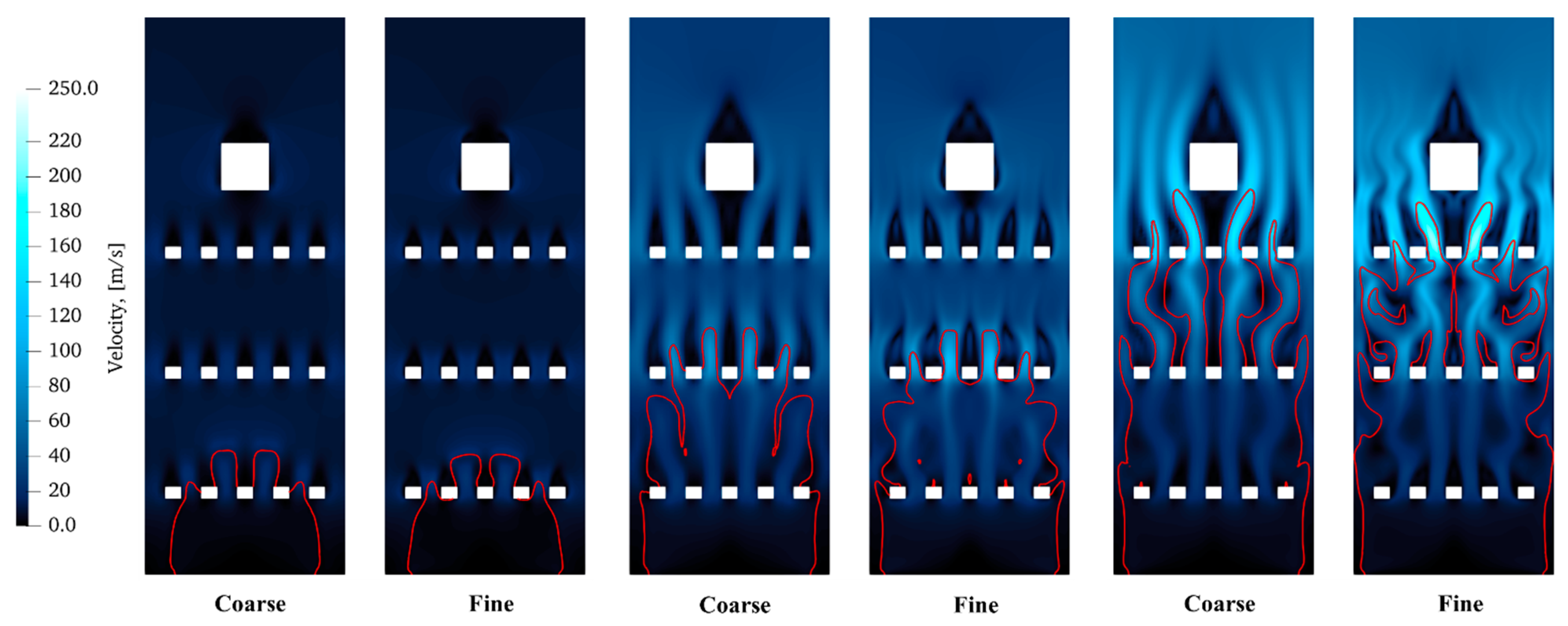



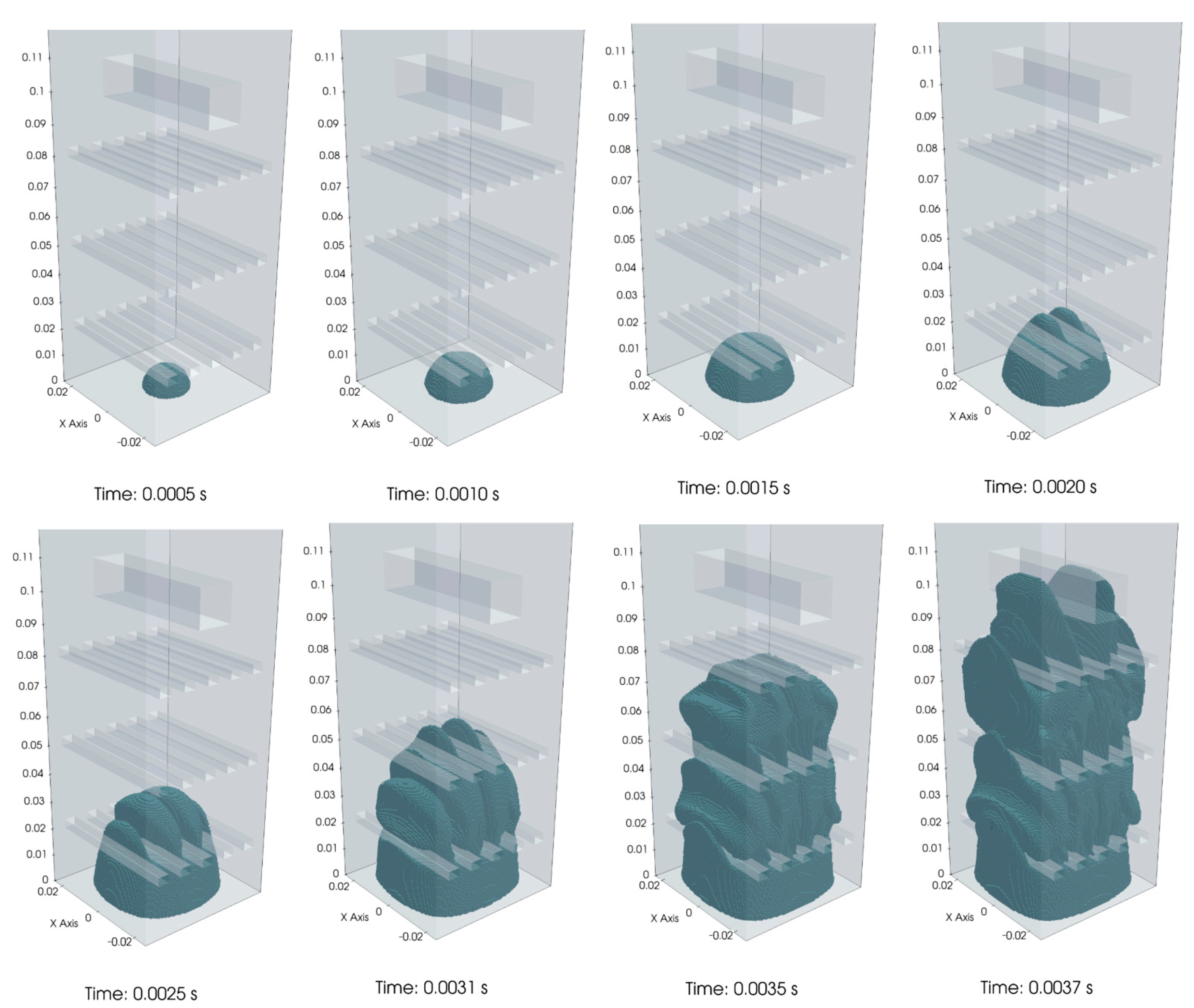
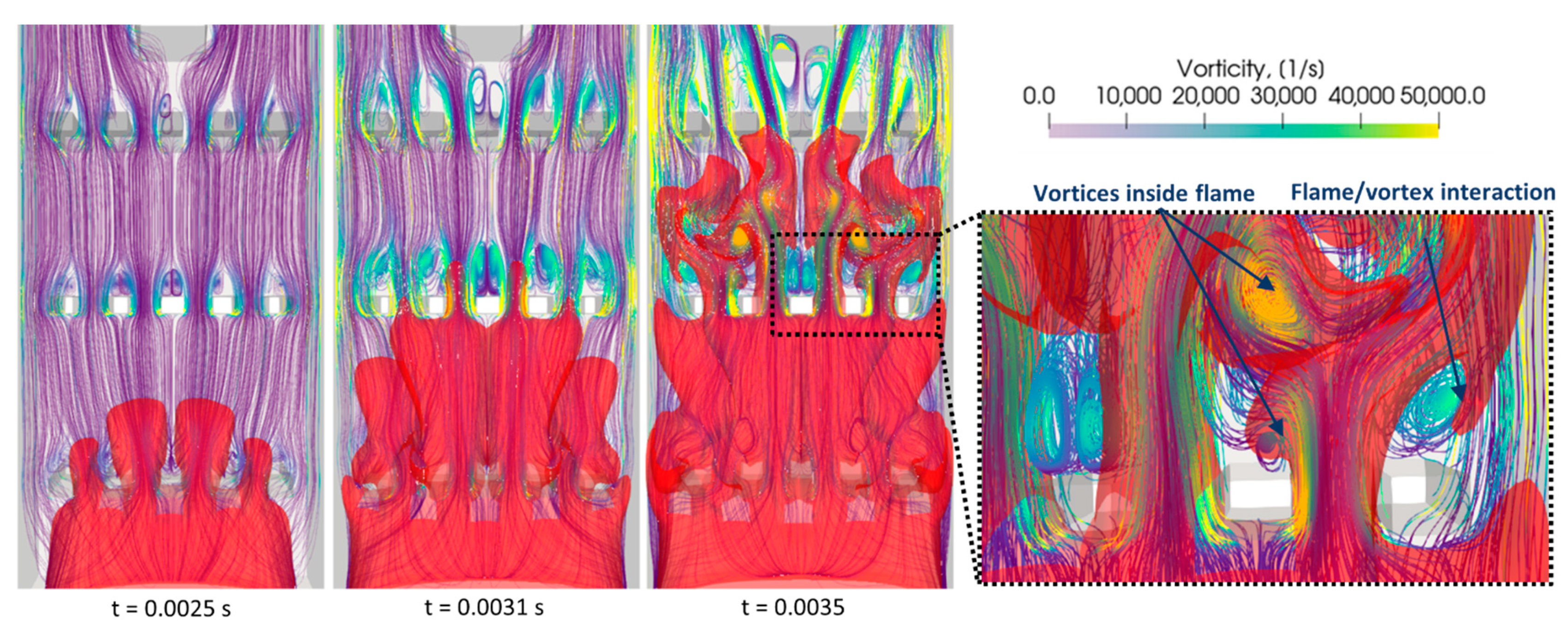
Publisher’s Note: MDPI stays neutral with regard to jurisdictional claims in published maps and institutional affiliations. |
© 2021 by the authors. Licensee MDPI, Basel, Switzerland. This article is an open access article distributed under the terms and conditions of the Creative Commons Attribution (CC BY) license (https://creativecommons.org/licenses/by/4.0/).
Share and Cite
Jaseliūnaitė, J.; Povilaitis, M.; Stučinskaitė, I. RANS- and TFC-Based Simulation of Turbulent Combustion in a Small-Scale Venting Chamber. Energies 2021, 14, 5710. https://doi.org/10.3390/en14185710
Jaseliūnaitė J, Povilaitis M, Stučinskaitė I. RANS- and TFC-Based Simulation of Turbulent Combustion in a Small-Scale Venting Chamber. Energies. 2021; 14(18):5710. https://doi.org/10.3390/en14185710
Chicago/Turabian StyleJaseliūnaitė, Justina, Mantas Povilaitis, and Ieva Stučinskaitė. 2021. "RANS- and TFC-Based Simulation of Turbulent Combustion in a Small-Scale Venting Chamber" Energies 14, no. 18: 5710. https://doi.org/10.3390/en14185710







